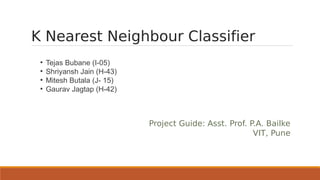Knn
- 1. K Nearest Neighbour Classifier ÔùÅ Tejas Bubane (I-05) ÔùÅ Shriyansh Jain (H-43) ÔùÅ Mitesh Butala (J- 15) ÔùÅ Gaurav Jagtap (H-42) Project Guide: Asst. Prof. P.A. Bailke VIT, Pune
- 2. TF-IDF Values ÔùÅ Term Frequency (TF): Importance of the term within that document ÔÇô raw frequency i.e. TF(d,t) = Number of occurrences of the term(t) in the document(d) ÔùÅ Inverse Document Frequency (IDF): Importance of the term in the corpus IDF(t) = log(D/t) where, D = total number of documents t = number of documents in which the term has occurred word occurs in many documents ÔÇô less useful ÔÇô IDF value low (and vice-versa) ÔùÅ TF-IDF(d,t) = TF(d,t) ├ù IDF(t)
- 3. KNN - Introduction ÔùÅ Learning by analogy ÔÇô comparison with similar items from training set ÔùÅ Training tuples described by n attributes ÔÇô each document represents a point in n dimensional space ÔùÅ Closeness defined in terms of distance metric eg. Euclidean distance, Cosine similarity, Manhattan distance ÔùÅ ÔùÅ Cos = 1 i.e. Angle = 0 documents are similar ÔùÅ Cos = 0 i.e. Angle = 90 documents are not similar
- 4. KNN Algorithm ÔùÅ Find cosine distance of query document with each document in the training set ÔùÅ Find the k documents that are closest / nearest to the query document ÔùÅ Class of query is the class of majority of the nearest neighbours (classes of each document in the training set are known)
- 5. Further Analysis of Classification ÔùÅ Lazy Learner : Starts operation only after a query is provided eg. KNN (calculates TF-IDF values after receiving query) ÔùÅ Eager Learner : Operates and keeps ÔÇ£learningÔÇØ till query is received. eg. ANN (adjusts weights before receiving query) ÔùÅ Supervised Learning : Labelled training data eg. Classification ÔùÅ Unsupervised Learning : Find hidded structure in unlabelled data eg. Clusturing ÔùÅ KNN is Supervised Learning Algorithm and follows Lazy Learning approach
- 6. Scaling KNN ÔùÅ Vocabulary ÔÇô Set of all words occurring in all documents ÔùÅ Large data set ÔÇô Drastic increase in the vocabulary ÔÇô difficult to handle ÔùÅ Feature Selection ÔÇô Relation between terms in vocabulary and classes Remove words which are less related (below threshold) to all classes Reduce vocabulary to make it manageable ÔùÅ eg. Chi-square test






